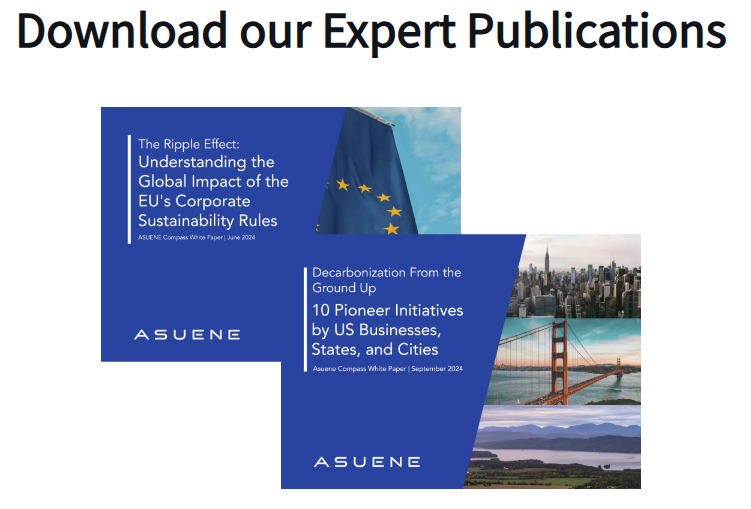- Article Summary
-
Carbon trading is not just a trend
—it is a game-changing tool that is reshaping how businesses view emissions. It all began with the European Union’s Emissions Trading Scheme (EU ETS) in 2005, which quickly grew into the world’s largest carbon market. Since then, carbon trading has been at the forefront of global efforts to reduce greenhouse gas (GHG) emissions, driving the shift to a more sustainable future. Over the years, carbon pricing has evolved into a crucial business strategy, offering cost-effective solutions and bringing new opportunities, while supporting corporate social responsibility goals. But what exactly is carbon trading?
You may be thinking it is too late to ask, but do not worry—Asuene has got your back. We have broken it down so you can see how carbon trading can benefit your business.
What Is Carbon Trading?
Carbon trading (also known as carbon emissions trading or cap-and-trade) is a market-based approach designed to reduce GHG emissions, particularly CO2,
which contributes to climate change.
Here is how it works:
- Cap-and-Trade System: A governing entity (e.g. a country or a group of countries) sets a cap on how much GHG can be emitted by regulated industries or sectors.
- Carbon Credits: Companies are provided with carbon credits that allow them to emit a specific amount of CO2. Each carbon credit represents the right to emit one ton of CO2 or its equivalent.
- Trading: If a company emits less than its allocated allowance, it can sell its surplus credits to other companies that exceed their limit. This creates a market where companies that effectively reduce emissions can profit by selling their unused credits. Those struggling to meet their targets can purchase additional credits from the market, enabling them to comply with regulations and avoid penalties.
This system establishes a dynamic marketplace for carbon credits within the economy, ensuring that total emissions remain within the set cap. By facilitating the trading of credits, it provides businesses with a financial incentive to adopt cleaner technologies and reduce their emissions efficiently. Over time, as the cap is progressively lowered, the total allowable emissions decrease, fostering collective efforts to reduce greenhouse gas levels and combat climate change.
Global Carbon Pricing: Milestones in 2024
Carbon pricing has successfully incentivized businesses to adopt greener practices. According to the World Bank’s State and Trends of Carbon Pricing 2024 report, carbon pricing instruments now cover approximately 24% of global emissions, with 75 carbon taxes and emissions trading schemes (ETSs) in place worldwide. If the instruments currently under consideration are implemented, the potential coverage could rise to 30%. The continued expansion of the carbon market has driven substantial revenue generation, with over $100 billion raised through carbon pricing in 2023. Most notably, more than half of the collected revenues were allocated to climate-focused initiatives, further supporting the creation of a sustainable future.
I know, it is a lot of numbers. But here is the real takeaway: carbon pricing is a powerful, globally embraced strategy that is not only driving us toward a greener world, but also sparking businesses to embrace sustainability like never before.
The challenges Carbon Market Is Facing
The carbon market has made remarkable progress, but it still faces significant challenges. One of the biggest hurdles is the uneven pace of implementation across regions. Middle-income countries like Brazil, India, and Türkiye are working toward adopting carbon trading, but the path is far from straightforward. Political uncertainties, economic pressures, and infrastructural limitations often slow progress, making it difficult to achieve the global consistency needed to effectively combat climate change.
At the subnational level, many regional and state-level initiatives are emerging. However, these efforts often encounter resistance from industries, local governments, or even the public. Policy inconsistencies and enforcement challenges can add confusion and create gaps in the system, limiting its overall effectiveness.
Despite these obstacles, the growing global momentum for carbon pricing is a promising sign. As more countries and regions dedicate themselves to action, there is a tremendous opportunity to address these challenges through collaboration, innovation, and a shared dedication to building a more sustainable future.
In addition to regional efforts, sector-specific initiatives are also playing a significant role in driving global emissions reductions. The aviation and shipping industries, for example, have seen progress through multilateral agreements aimed at curbing their substantial greenhouse gas emissions. The International Maritime Organization (IMO) recently adopted a revised greenhouse gas (GHG) emissions strategy in July 2023. This new strategy sets an ambitious target for the international shipping industry to reach net-zero emissions by or around 2050, compared to the 2018 strategy’s target of reducing emissions by 50% by 2050, based on 2008 levels. This more stringent goal reflects the IMO’s commitment to addressing the shipping sector’s significant environmental impact and aligns with global efforts to reduce emissions across all industries.
Another important development is the European Union’s Carbon Border Adjustment Mechanism (CBAM), which went into effect in 2023. This mechanism requires importers to report and pay for the carbon emissions embedded in products like steel, cement, and aluminum starting in 2026. The goal is to level the playing field for businesses within the EU, ensuring that goods produced in countries without carbon pricing schemes don’t gain a competitive advantage. This could have a significant impact on industries around the world, as companies will now have to factor in carbon costs when trading across borders, encouraging cleaner production practices globally.
These sector-specific initiatives are just the beginning of a broader trend toward stricter environmental accountability. Companies are being pushed toward greener practices—not only because of regulatory pressures but also due to the growing consumer demand for sustainable products. The implementation of mechanisms like the CBAM signals a shift toward a future where businesses must take responsibility for their environmental impact, both in their operations and in the goods they export. As this trend accelerates, it will become increasingly important for businesses to adapt to these new requirements and integrate sustainability into their core strategies.
Looking ahead, the landscape of carbon markets is evolving rapidly. While the path to a global carbon pricing system remains complex, the collective efforts of governments, industries, and consumers are creating a foundation for a more sustainable future. For businesses, staying informed about these developments and being adaptable to the changes ahead will be key to navigating this dynamic environment successfully.

Empower Your Businesses with Carbon EX
Navigating the world of carbon trading and achieving sustainability goals can be complex, but with the right tools and expertise, your business can thrive in this rapidly evolving space. That’s where ASUENE USA Inc. comes in.
As the U.S. entity of Asuene Inc., a leading Climate Tech company based in Japan, ASUENE USA provides innovative solutions like our Carbon EX platform and tailored support for carbon credits and Renewable Energy Certificates (RECs). Our Carbon EX platform makes carbon trading easy, whether you are looking to buy, sell, or retire carbon credits. With seamless integration into carbon markets and a user-friendly interface, our platform helps businesses participate in global emissions reduction efforts.
Beyond carbon credit trading, we offer a full suite of solutions, including carbon accounting software and ESG rating services. By automating the data collection process and providing actionable insights, ASUENE USA’s comprehensive platform helps you reduce manual labor and associated costs.
With over 10,000 clients globally and as a trusted partner of CDP, ASUENE USA is a reliable ally in navigating the world of carbon trading and decarbonization. Let us help you achieve your carbon-neutral goals and make a positive impact on both your business and the planet. Visit our Carbon EX platform to learn more or reach out for a tailored consultation. Together, we can drive meaningful environmental change.
